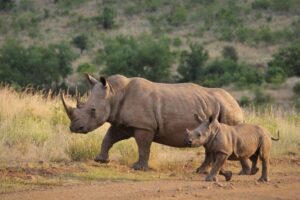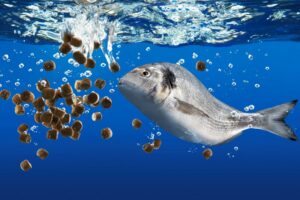Focus on the Environment Part 4: Nature Conservation
July 4, 2022We’ve had a focus over the last couple of months on environmental issues, with a look at how computer vison can assist recycling, support our oceans and tackle pollution more generally. The final part of our series looks into conserving nature and biological ecosystems.
Benefits for wildlife conservation
As reported by Novus Light a while ago, rhino poaching is on the increase, fueled by the value of rhino horn outstripping that of gold, pound for pound. The World Wildlife Fund (WWF) is working in Kenya with FLIR to install a system of thermal handheld cameras, fix-mounted perimeter security cameras, drone and automotive cameras to monitor and control poachers endangering rhinos, elephants and other game.
Wildlife Protection Solutions (WPS), a non-profit organization in the States, has gone one step further. They’ve developed a machine learning platform which identifies poaching behavior from other legal activity, allowing controllers to have to view far less video footage to pinpoint suspicious activities and act faster to intervene.
DeepMind in the UK has also put its expertise to ecological use. The team have developed a machine learning platform to support the counting of animals and species across the vast Serengeti. Hundreds of motion-triggered cameras have already been set up in protected areas of the Serengeti-Mara ecosystem, and, previously, volunteers and researchers have trawled through thousands of hours of footage to label and monitor the animals, their growth and movement. DeepMind are now piloting a system that they say is as accurate, or even slightly more accurate, than a human labeler, and will reduce the timeline to receiving full data on the ecosystem from around 12 to just 3 months.
However, you don’t need to be a Google-owned mega team to save the planet. In this very accessible article, Kasim Rafiq, a wildlife biologist at UC Santa Cruz, explains how he went about building a data set and machine learning solution to identify leopard behavior using tourist photographs and a Raspberry Pi.
Sustainable trawling
![]() Our seas and rivers provide the largest ecosystem on the planet, and maintaining the natural balance in our waterways has far-reaching consequences. Commercial fishing methods have long been criticized as detrimental to nature, so it’s a sector that’s seen a huge amount of investment and research.
Our seas and rivers provide the largest ecosystem on the planet, and maintaining the natural balance in our waterways has far-reaching consequences. Commercial fishing methods have long been criticized as detrimental to nature, so it’s a sector that’s seen a huge amount of investment and research.
Modern trawler fishing involves dragging enormous fishing nets across the ocean floor in a way that has meant death and destruction for anything in its path – be that fish, coral or other marine animals. Species and sizes of fish that may be outside legal guidelines are also caught and the devastation and waste from this method has been contentious for some time. Around a quarter of all global fishing catches are discarded[1] and waste can be as high as 80% in the case of trawling[2].
France’s National Institute for Ocean Science, Ifremer, is piloting a new innovation known as Game of Trawls (Giving Artificial, Monitoring intelligence to Fishing Trawls). This AI-powered fishing net aims to identify the catch at the bottom of the sea and release unwanted, undersized or prohibited contents before removing them from the water. Cameras and sensors along with classification software are used to scrutinize what’s at the opening of the net, and take action if the wrong catch is detected; escape devices in the trawl net are activated to allow larger amounts of unwanted fish and creatures to remain in the sea.
SMARTFISH H2020 is an EU-funded international research project to support sustainable fishing. One team from Norwegian organization SINTEF Ocean is working on a project called SmartGear, a system that uses LED technology to optimize the catching performance of trawling nets, based on the reaction of various fish to different intensities of light, and deterring unwanted species.
Imaging in pisciculture
Technology is well-established in fish farming to optimize output, as we reported a couple of years ago. Now it’s being used to minimize the industry’s environmental impact as well.
Feeding the right amount of pellets to farmed fish not only saves money on wasted feed but also prevents left over food contaminating the surrounding water. JT electric offers algorithmic software called FeedTracker alongside their OceanCamera to recognize pellets in the water and advise farmers to reduce the amount used when surplus feed is present. The system uses two cameras, one facing upwards to monitor pellets descending, and the second watches the fishes’ response to feed in the water and determine their appetite. Seabed pollution is reduced, along with the overall wastage of food.
Computer vision reduces the environmental footprint of agriculture
![]() Waste from farming is widely known to be harmful to the environment. From methane-making cows to pesticide run-off in rivers, maintaining sustainability is an ongoing challenge. We’ve looked at the role of computer vision for agritech before, and we know that hyperspectral imaging is being more widely introduced to monitor the condition of crops and to know just how much water, fertilizer and pesticide is required according to the status of individual plants. Drone developments are particularly driving this area, with the agricultural drone market expected to grow from US$1.2 billion in 2020 to US45.7 billion by 2025[3]. This all bodes well for the environment as we should see a decline in the amount of chemicals being used on farm land, and a reduction in poisons and chemical pollutants entering the natural surroundings.
Waste from farming is widely known to be harmful to the environment. From methane-making cows to pesticide run-off in rivers, maintaining sustainability is an ongoing challenge. We’ve looked at the role of computer vision for agritech before, and we know that hyperspectral imaging is being more widely introduced to monitor the condition of crops and to know just how much water, fertilizer and pesticide is required according to the status of individual plants. Drone developments are particularly driving this area, with the agricultural drone market expected to grow from US$1.2 billion in 2020 to US45.7 billion by 2025[3]. This all bodes well for the environment as we should see a decline in the amount of chemicals being used on farm land, and a reduction in poisons and chemical pollutants entering the natural surroundings.
Closer to the ground, the development of the LaserWeeder by US based Carbon Robotics promises to abolish the need for herbicides completely by eliminating weeds with lasers instead of chemicals. High-resolution cameras provide a live feed of plants as the robot vehicle passes over them, image processing software identifies the weeds from the crop and blasts them dead with thermal energy from a CO2 laser. It sounds so simple it’s hard to believe it’s not already a globally established method of organic farming!
Customized computer vision solutions
At Active Silicon, we’ve been creating computer vision solutions for over 30 years. Our extensive range of autofocus-zoom cameras offer flexible surveillance options, and our high-speed frame grabbers capture and process images at lightning speed. For a more customized platform, we can tailor an embedded system to your exact requirements. Get in touch to see what we can bring to your environmental project, or indeed any other vision challenge.
[1] A third assessment of global marine fisheries discards (fao.org)
[2] The ‘Game of Trawls’: smart fishing nets could save millions of sea creatures – YouTube
[3] Agriculture Drones Market Size Share | 2020-2025 | Industry Report | MarketsandMarkets™